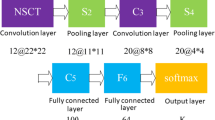Abstract
Convolutional neural networks (CNNs) have been used in several classification tasks. This study aims to evaluate the performance of CNN methods for land-use classification. CNN-based model was evaluated on aerial orthophoto data for land-use scene classification. Ground-truth data set containing 25 253 records with known land-use category were used to train the CNN model to solve a practical issue. The overall accuracy of the best model on the test data set was 94.00%. The obtained results indicated that CNN mode showed high accuracy and is suitable for land-use classification tasks.












Similar content being viewed by others
REFERENCES
Cao, C., Dragicevic, S., and Li, S., Land-use change detection with convolutional neural network methods, Environments, 2019, vol. 6, no. 25, pp. 1–15.
Newton, K., International Relations and World Politics, Ed-Tech Press, 2018.
Yang, C., Rottensteiner, F., and Heipke, C., Classification of land cover and land use based on convolutional neural networks, in ISPRS Annals of the Photogrammetry, Remote Sensing and Spatial Information Sciences, Beijing, 2018, vol. IV-3, pp. 251–258.
Pettorelli, N., Satellite Remote Sensing and the Management of Natural Resources, OUP Oxford, 2019.
Punmia, B.C., Jain, A.K., and Jain, A.K., Higher Surveying, Laxmi Publ., 2005, no. 3.
Joseph, G., Fundamentals of Remote Sensing, Orient Blackswan, 2005.
Benuwa, B.B., Zhan, Y., Ghansah, B., Wornyo, D.K., and Kataka, F.B., A review of deep machine learning, Int. J. Eng. Res. Afr., 2016, vol. 24, pp. 124–136.
Liu, J., Li, H., Wu, R., Zhao, Q., Guo, Y., and Chen, L., A survey on deep learning methods for scene flow estimation, Pattern Recognit., 2020, vol. 106, no. 107378.
Mosavi, A., Ardabili, S., and Varkonyi-Koczy, A.R., List of deep learning models, Engineering for Sustainable Future: Selected Papers of the 18th International Conference on Global Research and Education Inter-Academia – 2019, Budapest and Balatonfüred, 2020, vol. 101, no. 1, pp. 202–214.
Xia, G.S., Hu, J., Hu, F., Shi, B., Bai, X., Zhong, Y., and Zhang, L., AID: A benchmark dataset for performance evaluation of aerial scene classification, IEEE Trans. Geosci. Remote Sens., 2017, vol. 55, no. 7, pp. 3965–3981.
Lyra, M., Ploussi, A., and Georgantzoglou, A., MATLAB as a tool in nuclear medicine image processing, in MATLAB - A Ubiquitous Tool for the Practical Engineer, Ionescu, C.M., Ed., Rijeka: IntechOpen, 2011, pp. 477–500.
Goodfellow, I., Bengio, Y., and Courville, A., Deep Learning (Adaptive Computation and Machine Learning Series), MIT Press, 2016.
Kingma, D.P. and Ba, J., ADAM: A method for stochastic optimization, Proc. of the 3rd International Conference on Learning Representations, San Diego, CA, 2015, pp. 1–15.
Shiruru, K., An introduction to artificial neural network, Int. J. Adv. Res. Innovative Ideas Educ., 2016, vol. 1, no. 5, pp. 27–30.
Ciaburro, G. and Venkateswaran, B., Neural Networks with R: Smart Models Using CNN, RNN, Deep Learning, and Artificial Intelligence Principles, Packt Publ., 2017.
Ghatak, A., Deep Learning with R, Singapore: Springer Singapore, 2019.
Alom, M.Z., Taha, T.M., Yakopcic, C., Westberg, S., Sidike, P., Nasrin, M.S., Hasan, M., Essen, B.C.V., Awwal, A.A.S., and Asari, V.K., A state-of-the-art survey on deep learning theory and architectures, Electronics, 2019, vol. 8, no. 3, pp. 292–359.
Al-Zuhairi, M., Pradhan, B., and Aziz, O.S., Classification of very high resolution aerial photos using spectral-spatial convolutional neural networks, J. Sens., 2018, vol. 1, no. 2.
Kong, Q., Yu, C., Iqbal, T., Xu, Y., Wang, W., and Plumbley, M.D., Weakly labelled audioset tagging with attention neural networks, IEEE/ACM Trans. Audio Speech Lang. Process., 2019, vol. 27, no. 11, pp. 1791–1802.
Color Orthophoto Map 2016–2018 (Cycle 6). https://www.lgia.gov.lv/en/color-orthophoto-map-2016-2018-cycle-6. Cited August 27, 2020.
Jamel, T.M. and Mohammed, B., Implementation of a sigmoid activation function for neural network using FPGA, Proc. of 13th Scientific Conference of Al-Ma’moon University College, Baghdad, 2012, vol. 13, p. 1–11.
Nwankpa, C., Ijomah, W., Gachagan, A., and Marshall, S., Activation functions: Comparison of trends in practice and research for deep learning. https://arxiv.org/abs/1811.03378. Cited August 27, 2020.
Deep Learning Studio (DLS). https://deepcognition.ai/. Cited August 27, 2020.
Author information
Authors and Affiliations
Corresponding author
Ethics declarations
The author declares no conflict of interest.
About this article
Cite this article
Stepchenko, A.M. Land-Use Classification Using Convolutional Neural Networks. Aut. Control Comp. Sci. 55, 358–367 (2021). https://doi.org/10.3103/S0146411621040088
Received:
Revised:
Accepted:
Published:
Issue Date:
DOI: https://doi.org/10.3103/S0146411621040088




